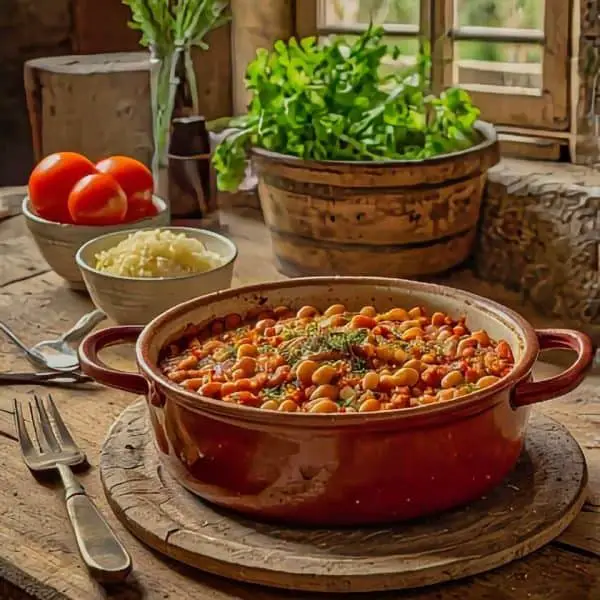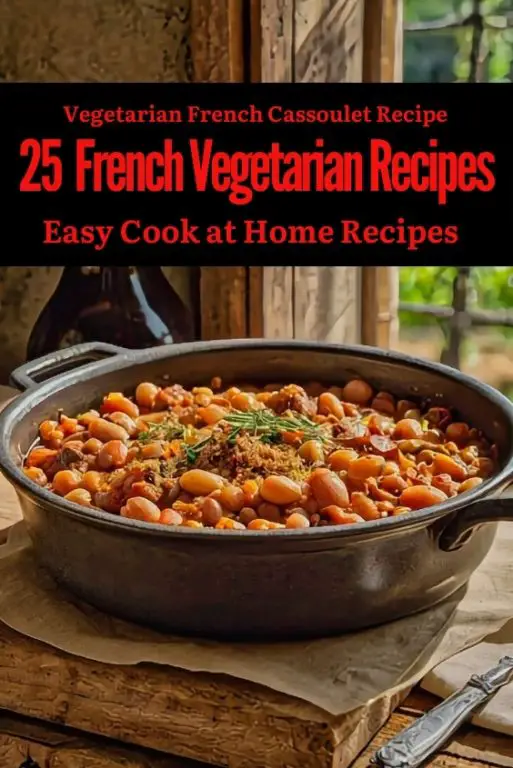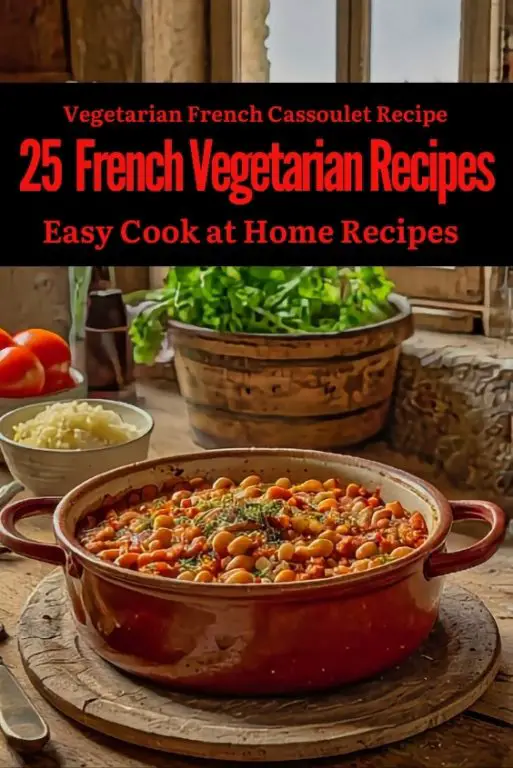The Vegetarian French Cassoulet recipe was the highlight of our local French cooking class. Our group gathered in a bright kitchen, excited and ready to learn. A cook from the area showed us how to do everything. It felt more personal because we each had our own cooking areas. The Vegetarian French Cassoulet Recipe was something that many of us had never tried before, it had hearty beans, fresh veggies, and sweet herbs inside.
We talked about the food as we got ready to cook. The cook stressed how important it was to carefully follow each step, especially for people who were just starting out. For the best taste, one important tip was to use fresh veggies. The kitchen smelled great as we chopped and prepared the food. It was fun to see everyone asking questions and working together. The class was lively and fun because of this.
The chef gave us simple but useful tips and the recipe as we stacked the ingredients for the Vegetarian French Cassoulet Recipe. He told us to try the food while it was cooking. By doing this, you can change the seasoning early on and make sure the taste is balanced. Besides that, he said to stir the pot a lot. This makes the tastes go together well. These tips are very important for people who are just starting to cook.
We learned how to cook with the heat turned down or up. The chef said that starting with low heat lets the beans cook all the way through without getting burned. People who are new to cooking can learn a lot from these classes.
Our group had made a big pot of the Vegetarian French Cassoulet Recipe by the end of each class. With its bright mix of beans and veggies, it looked hearty. We were given copies of the recipe by the cook, who encouraged us to make it at home. Not only was this fun, but it also taught me a lot. When I left, I felt more sure of myself in the kitchen. I couldnt wait to make the Vegetarian French Cassoulet Recipe for my family and readers of my blog.
Ingredients For the Vegetarian French Cassoulet Recipe
Olive Oil
Diced Large Onion
minced Cloves Garlic
Peeled and Diced Carrots
Diced Celery Stalks
Diced Red Bell Pepper
Dried Thyme
Dried Rosemary
Bay Leaf
White Beans
Diced Tomatoes
Vegetable Broth
Salt
Pepper
Bread Crumbs
Fresh parsley for garnish
Cooking Instructions For the Vegetarian French Cassoulet Recipe
- In a large pot or Dutch oven, heat the olive oil over medium heat. Add the diced onion and minced garlic to the pot and sauté until the onion becomes translucent. Add the diced carrots, celery, and red bell pepper to the pot. Cook for a few minutes until the vegetables start to soften.
- Stir in the dried thyme, dried rosemary, and bay leaf. Cook for another minute to release the aromas.
- Add the drained and rinsed white beans, diced tomatoes, and vegetable broth to the pot. Season with salt and pepper to taste. Bring the mixture to a boil, then reduce the heat to low. Cover the pot and simmer for about 20 minutes to allow the flavors to meld together.
- While the cassoulet is simmering, preheat the oven to 375°F (190°C).
- Transfer the simmered cassoulet mixture to a baking dish. Sprinkle the bread crumbs evenly over the top.
Bake in the preheated oven for 25-30 minutes or until the bread crumbs are golden and crispy. - Remove from the oven and let it cool for a few minutes. Garnish with fresh parsley before serving.
10 Reasons I love France Vegetarian Food
1. Fresh, Seasonal Ingredients
One of the best things about French vegetarian food is its emphasis on fresh, seasonal ingredients. Local markets in France offer a wide variety of vegetables, herbs, and fruits that reflect what is in season. This ensures that every dish is made with the ripest, freshest produce, giving the food a flavor and quality that’s hard to beat. French cooks pride themselves on using only the best ingredients, which makes even the simplest vegetable dishes taste exceptional.
2. Simple Yet Elegant
French vegetarian dishes are known for their simplicity, yet they are always prepared with an elegant touch. Many dishes require just a few ingredients, but the care and attention given to preparation result in meals that are refined and full of flavor. For example, a vegetable tart made with fresh zucchini, tomatoes, and onions can be a delightful dish when baked with a perfectly crisp pastry. This balance between simplicity and sophistication is what makes French vegetarian food so appealing.
3. Delicious Use of Herbs
Herbs play a significant role in French vegetarian cuisine, adding layers of flavor and aroma to dishes. Fresh herbs like thyme, rosemary, parsley, and tarragon are often used to enhance soups, stews, and roasted vegetables. French cooks also rely on herbes de Provence, a blend of dried herbs, to season vegetables and create delicious marinades. These herbs not only add fragrance to dishes but also elevate the natural flavors of the ingredients, giving the food a fresh and vibrant taste.
4. Rich in Tradition
French vegetarian food is steeped in culinary tradition, with many dishes having been passed down through generations. Classics like ratatouille, a vegetable stew from Provence, or tarte aux légumes, a savory vegetable tart, reflect the country’s rich food heritage. These dishes are not only beloved for their flavor but also for the cultural history they represent. Eating French vegetarian food often feels like experiencing a piece of France’s long-standing culinary traditions, making it a truly enriching experience.
5. Versatile Cooking Methods
French cuisine showcases a variety of cooking methods, each bringing out unique textures and flavors in vegetables. Roasting, for example, enhances the sweetness of root vegetables, while sautéing brings out the rich flavors of mushrooms and onions. Steaming preserves the freshness and nutrients of delicate greens, while baking creates crispy, golden crusts for vegetable tarts and gratins. This versatility allows French vegetarian dishes to offer diverse textures and flavors, ensuring that each meal is a delightful experience.
6. Cheese-Lover’s Dream
France is world-renowned for its wide selection of cheeses, and many vegetarian dishes incorporate these delicious ingredients. From soft and creamy goat cheese to the nutty flavors of gruyère and comté, French cheeses add richness and depth to vegetarian meals. Whether melted into a vegetable gratin, sprinkled over a salad, or baked into a tart, cheese plays a starring role in many French vegetarian dishes. For those who love cheese, French cuisine offers endless possibilities to indulge in flavorful, comforting meals.
7. Balanced Flavors
French vegetarian cuisine is all about balance. The flavors in each dish are carefully curated to complement one another, creating a harmonious taste experience. French cooks often use herbs and mild spices to enhance, rather than overpower, the natural flavors of vegetables. For example, in a dish like soupe au pistou, a vegetable soup with a basil-garlic sauce, the flavors of fresh vegetables are delicately balanced with the aromatic pistou, making the dish both satisfying and refreshing. This focus on balance is what makes French vegetarian dishes taste so refined.
8. Regional Specialties
One of the joys of French cuisine is the diversity of regional specialties, and this applies to vegetarian food as well. Each region of France has its own unique dishes that reflect the local ingredients and traditions. In Provence, for example, you’ll find vegetable-rich dishes like ratatouille and soupe au pistou, which highlight the region’s love for fresh produce and Mediterranean flavors. In Brittany, vegetarian buckwheat crêpes filled with vegetables and cheese are a local favorite. Exploring the regional varieties of French vegetarian food offers a chance to discover new flavors and cooking styles.
9. Healthy and Satisfying
French vegetarian cuisine is not only delicious but also healthy. The use of fresh vegetables, herbs, and olive oil creates meals that are both light and nutritious. French vegetarian dishes often focus on simple, wholesome ingredients that provide plenty of vitamins and nutrients without being heavy or overly rich. At the same time, these meals are filling and satisfying, thanks to the thoughtful combinations of vegetables, grains, and legumes. Whether it’s a hearty lentil stew or a light vegetable salad, French vegetarian food strikes the perfect balance between health and flavor.
10. Beautiful Presentation
In France, the presentation of food is almost as important as the taste. French cooks take great care in arranging their dishes, ensuring that the meal is as visually appealing as it is flavorful. Vegetarian dishes are often presented with vibrant colors, showcasing the freshness of the ingredients. A simple salad, for example, might be artfully arranged with bright green lettuce, ruby-red tomatoes, and a sprinkling of fresh herbs. This attention to detail elevates the dining experience, making every meal feel like a special occasion. The beauty of French vegetarian food lies not only in its taste but also in the artistry of its presentation.
Eating Healthy As A Vegetarian in France
Eating healthy as a vegetarian in France is both enjoyable and feasible, thanks to the country’s emphasis on fresh, high-quality ingredients. French markets are abundant with seasonal fruits, vegetables, legumes, and grains, allowing vegetarians to access nutrient-rich produce year-round. Local farmers’ markets, known as marchés, provide a wide array of options, from fresh greens to root vegetables, making it easy to prepare balanced, wholesome meals. This focus on seasonal ingredients ensures that vegetarians in France can enjoy meals packed with vitamins, minerals, and antioxidants.
French cuisine is traditionally known for its emphasis on vegetables and legumes, especially in regions like Provence. Dishes such as ratatouille—a stew made with tomatoes, zucchini, and eggplant—are naturally vegetarian and offer plenty of fiber, vitamins, and minerals. Soups, like soupe au pistou, made with fresh vegetables and herbs, are not only filling but also low in calories and full of essential nutrients. For protein, lentils and beans are commonly used, such as in lentil salad, which is a popular vegetarian option found in many French cafes and bistros.
One of the challenges of eating healthy as a vegetarian in France is navigating meals at restaurants, where meat-heavy dishes like coq au vin or cassoulet dominate the menu. However, many restaurants now offer vegetarian or plant-based options, and dishes like vegetable tarts, salads, and cheese-based gratins can be enjoyed without sacrificing nutrition. Pairing these meals with whole-grain bread, fresh fruit, and a glass of water or herbal tea keeps the diet balanced and healthy.
Overall, the emphasis on fresh produce, herbs, and high-quality ingredients in French cuisine makes it easy for vegetarians to maintain a nutritious diet while enjoying the rich flavors that define French cooking.
Vegetarian Diet in France
The history of the vegetarian diet in France spans centuries, evolving from ancient practices to modern dietary trends. In ancient times, vegetarianism was not a widespread practice in France, as the diet of the region was primarily based on agriculture, including the consumption of grains, vegetables, and some animal products. However, during the Roman occupation of Gaul (modern-day France), Roman influence introduced more diverse food habits, including an increased reliance on meat, fish, and dairy. While the ancient diet included many plant-based foods, there was no widespread cultural movement promoting vegetarianism.
During the Middle Ages, French diets remained largely agrarian, with peasants relying on vegetables, grains, legumes, and occasional dairy or meat when available. However, the religious orders in medieval France played a significant role in shaping early vegetarian practices. Monastic communities often abstained from meat during fasting periods, favoring plant-based meals, soups, and bread. These dietary restrictions were tied to religious observances, and while not purely vegetarian, they influenced early plant-based eating habits in France.
In the 19th century, vegetarianism began to emerge more formally in Europe, including France, as part of broader health movements and moral considerations. Influenced by the vegetarian philosophies gaining traction in Britain and Germany, French intellectuals and reformers started to explore plant-based diets. Figures like writer and philosopher Alphonse de Lamartine and the famous French lawyer Émile Zola were among those who discussed the ethical and health benefits of a vegetarian lifestyle. This period marked the beginning of vegetarianism as a conscious choice for health, ethics, and environmental concerns, though it remained a niche movement in France.
The modern vegetarian movement in France gained momentum in the 20th century, especially post-World War II, with increasing awareness of health and environmental issues. In the 1970s and 1980s, the rise of natural food stores and vegetarian restaurants began to reflect a growing demand for plant-based diets. Influenced by global trends in vegetarianism, including movements from the United States and India, French society slowly started to embrace vegetarian options, particularly in urban centers like Paris.
Today, vegetarianism is more mainstream in France, though it remains less prevalent than in some other European countries. Many French people, especially in urban areas, adopt vegetarian or flexitarian diets for health, ethical, or environmental reasons. With a greater variety of vegetarian products available in supermarkets and the rise of plant-based restaurants, the vegetarian diet has become a significant part of modern French food culture.
FAQ For the Vegetarian French Cassoulet Recipe
Q: What ingredients are essential for a Vegetarian French Cassoulet Recipe?
A: A Vegetarian French Cassoulet Recipe relies on a variety of hearty ingredients that create a rich, flavourful dish. The primary components include white beans, such as cannellini or navy beans, which provide protein and texture. Additionally, vegetables like carrots, celery, and onions form the base, while garlic adds aromatic depth. For flavour, use vegetable broth and fresh herbs like thyme and bay leaves. Some recipes also incorporate mushrooms or eggplant for extra richness. The combination of these ingredients simulates the traditional cassoulet while keeping it vegetarian-friendly and satisfying.
Q: How do you prepare the beans for a Vegetarian French Cassoulet Recipe?
A: Preparing the beans for a Vegetarian French Cassoulet Recipe is essential for achieving the right texture. If using dried beans, start by soaking them overnight in water to soften. Drain and rinse the beans before cooking them in a pot of fresh water until tender, which usually takes about an hour. If using canned beans, simply rinse them under cold water to remove excess sodium before adding them to the cassoulet. This step ensures that the beans meld well with the other ingredients and absorb the dish’s rich flavours.
Q: Can you make a Vegetarian French Cassoulet Recipe in advance?
A: Yes, a Vegetarian French Cassoulet Recipe can be made in advance, making it a convenient option for meal prep. You can prepare the entire dish up to the baking step and store it in the refrigerator for a day or two. When you’re ready to serve, simply cover it with foil and bake until heated through. Alternatively, you can freeze the assembled cassoulet for longer storage. Just be sure to thaw it in the refrigerator overnight before baking to retain the best flavour and texture.
Q: How do you serve a Vegetarian French Cassoulet Recipe?
A: A Vegetarian French Cassoulet Recipe is typically served warm and can be accompanied by various sides to enhance the meal. A simple green salad dressed with a light vinaigrette makes for a refreshing contrast to the hearty cassoulet. Additionally, crusty bread or baguette slices are perfect for soaking up the delicious sauce. For a touch of elegance, garnish the cassoulet with fresh herbs, such as parsley or thyme, before serving. This presentation adds colour and freshness, enhancing both the flavour and visual appeal of the dish.
Q: What are some variations of the Vegetarian French Cassoulet Recipe?
A: There are numerous variations of the Vegetarian French Cassoulet Recipe to suit different tastes and preferences. You can include a variety of vegetables such as zucchini, bell peppers, or spinach for added nutrition and flavour. For a smoky taste, consider adding smoked paprika or using smoked tofu. Additionally, some recipes incorporate lentils or chickpeas instead of beans for a different texture. Adjusting the herbs and spices allows for personalisation, ensuring the dish remains vibrant while catering to individual palates.

French Vegetarian Cassoulet Recipe
Equipment
- Large pot or Dutch oven
- Cutting board and knife
- Wooden spoon or spatula
- Measuring spoons and cups
- Can opener
Ingredients
- 1 tablespoon olive oil
- 1 large onion diced
- 3 cloves garlic minced
- 2 carrots peeled and chopped
- 2 celery stalks chopped
- 1 red bell pepper diced
- 1 14.5-ounce can diced tomatoes
- 2 15-ounce cans white beans, drained and rinsed
- 1 cup vegetable broth
- 1 teaspoon dried thyme
- 1 teaspoon dried rosemary
- 1 bay leaf
- 8 ounces firm tofu drained and cubed
- Salt and pepper to taste
- Fresh parsley chopped (for garnish)
Instructions
- Heat the olive oil in a large pot over medium heat.
- Add the diced onion and minced garlic to the pot. Sauté for about 5 minutes until the onion becomes translucent.
- Add the chopped carrots, celery, and red bell pepper to the pot. Cook for another 5 minutes until the vegetables begin to soften.
- Pour in the diced tomatoes, white beans, and vegetable broth. Stir well to combine.
- Add the dried thyme, dried rosemary, and bay leaf to the pot. Season with salt and pepper to taste.
- Bring the mixture to a boil, then reduce the heat to low. Cover the pot and let it simmer for about 20 minutes, allowing the flavors to meld together.
- After 20 minutes, remove the lid and add the cubed tofu to the pot. Stir gently to incorporate the tofu into the mixture.
- Continue to cook for an additional 10 minutes to allow the tofu to heat through.
- Taste and adjust the seasoning if needed.
- 10.Remove the bay leaf from the pot before serving.
- Serve the Vegetarian Cassoulet in bowls, garnished with fresh parsley.





4 comments
So hearty and delicious! The flavors melded perfectly in this cassoulet, creating a warm and comforting dish. I paired it with a green salad, making for a complete meal.
I cant believe they left out the traditional meat in the Cassoulet recipe! Are we messing with French cuisine too much here, or is it a tasty twist? Lets discuss!
I appreciate the creativity of a vegetarian twist on a classic French dish like cassoulet. However, Im curious if using meat substitutes truly captures the essence of the original recipe. What do you think?
I cant believe they left out the secret ingredient for the Vegetarian French Cassoulet Recipe! Its like theyre holding out on us. What other surprises are they hiding?
Comments are closed.